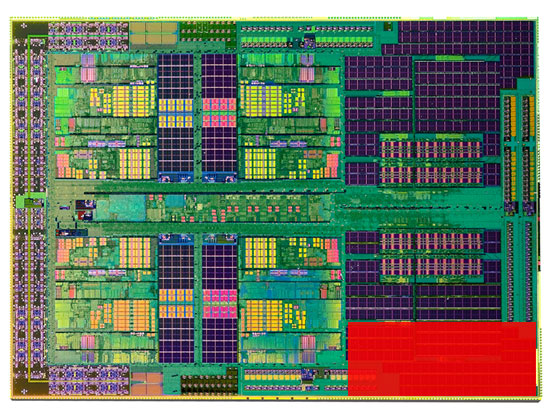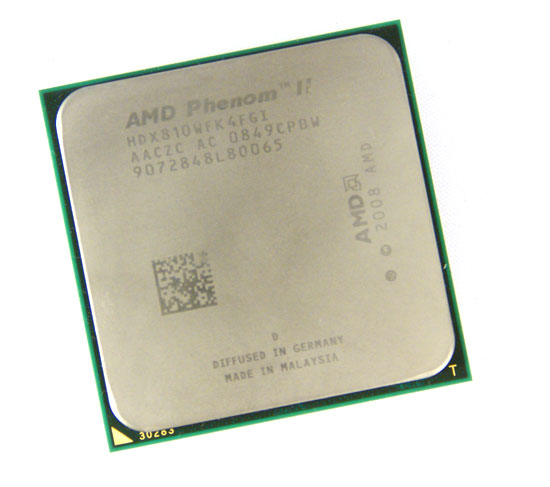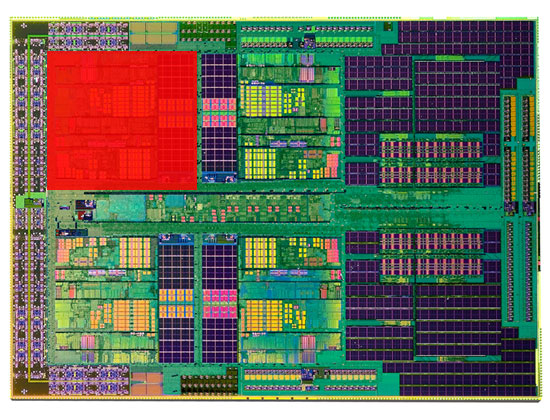The Phenom II X4 810 & X3 720: AMD Gets DDR3 But Doesn't Need It
by Anand Lal Shimpi on February 9, 2009 12:00 AM EST- Posted in
- CPUs
We're in the midst of a price war folks, and at a time when the global economy is looking a little shaky this actually works very well for us. Let's recap what's happened.
AMD launched its first truly competitive CPUs in over two years in January: the Phenom II X4 940 and 920. Priced at $275 and $235 respectively, these two chips beat out the equivalently priced Intel CPUs, the Q9400 and the Q8200. If you haven't already, I would strongly suggest reading that article in order to get the background information necessary about what was changed in Phenom II to make it so competitive.
Less than two weeks later Intel responded by cutting its quad core prices. The table below shows what happened:
| Processor | Dec '08 Price | Jan '09 Price | % Decrease |
| Intel Core 2 Quad Q9650 (3.00GHz) | $530 | $316 | 40% |
| Intel Core 2 Quad Q9550 (2.83GHz) | $316 | $266 | 16% |
| Intel Core 2 Quad Q9400 (2.66GHz) | $266 | $213 | 20% |
| Intel Core 2 Quad Q8300 (2.50GHz) | $224 | $183 | 18% |
| Intel Core 2 Quad Q8200 (2.33GHz) | $193 | $163 | 16% |
AMD responded immediately, cutting its Phenom II prices to match:
| Processor | Launch Price | New Price | % Decrease |
| AMD Phenom II X4 940 (3.0GHz) | $275 | $225 | 18% |
| AMD Phenom II X4 920 (2.8GHz) | $235 | $195 | 17% |
We really have to applaud both companies here. Intel for responding so quickly and effectively; the 40% price drop on the Q9650 just made sense and now you can have a chip with 12MB of L2 cache for under $300 thanks to the Q9550. And we have to thank AMD for keeping the pressure on and making this possible.
The Phenom II X4 940 is once more priced similar to the Core 2 Quad Q9400, while the 920 is sort of in between a Q8300 and a Q9400. Based on last month's article we know that the Phenom II X4 940 is a better buy than the Core 2 Quad Q9400, but the 920 is a tougher sell compared to the Q8300/Q9400.
Phenom II: Now in Three Flavors
Things get more complicated with today's announcement; AMD is launching no less than five new Phenom II CPUs. Their specs and model numbers are below:
| Processor | Clock Speed | un-core Clock | L2 Cache | L3 Cache | TDP | Price |
| AMD Phenom II X4 940 | 3.0GHz | 1.8GHz | 2MB | 6MB | 125W | $225 |
| AMD Phenom II X4 920 | 2.8GHz | 1.8GHz | 2MB | 6MB | 125W | $195 |
| AMD Phenom II X4 910 | 2.6GHz | 2.0GHz | 2MB | 6MB | 95W | $??? |
| AMD Phenom II X4 810 | 2.6GHz | 2.0GHz | 2MB | 4MB | 95W | $175 |
| AMD Phenom II X4 805 | 2.5GHz | 2.0GHz | 2MB | 4MB | 95W | $??? |
| AMD Phenom II X3 720 BE | 2.8GHz | 2.0GHz | 1.5MB | 6MB | 95W | $145 |
| AMD Phenom II X3 710 | 2.6GHz | 2.0GHz | 1.5MB | 6MB | 95W | $??? |
| AMD Phenom 9950 | 2.6GHz | 2.0GHz | 2MB | 2MB | 140W | $173 |
The Phenom II X4 910 is just a lower clocked version of the CPUs we reviewed last month. The 800 series is a bit more unique, albeit not in a good way. The 900 series all have 2MB of L2 cache on die and a 6MB L3; the 800 shrinks the L3 down to 4MB. If you remember back to our original Phenom II article I argued that a big reason for the original Phenom's failure was that it didn't have a large-enough L3 cache. With a 6MB L3 the 900 series seemed like a good balance between L2 and L3 cache size, but going any smaller than 6MB could prove to be overly detrimental to performance. Also keep in mind that Intel's Ronak Singhal was adament that Nehalem shouldn't have any less than an 8MB L3 (or 2MB per core), even the mainstream Core i7 derivatives are slated to have 2MB of L3 cache per core (4MB for the dual-core versions).

A Phenom II X4 900 series die: 258mm2, 4-cores and a 6MB L3 cache
The 800 series is simply an example of die harvesting. Some of the die have too many defects in the L3 cache, but fully functional cores. Instead of throwing away these CPUs AMD turns them into the Phenom II X4 800 series. While physically the same die size and transistor count of the 900 series, these chips simply have some of the L3 cache disabled:

A Phenom II X4 800 series die: 258mm2, 4-cores and a 4MB L3 cache

We've also got the Phenom II X3 720 and 710. These are both triple-core derivatives, once again they are physically the same die as the Phenom II X4 900 series, but this time with only 3 cores enabled. These are further harvested parts used simply to improve yields. I suspect that between the Phenom II 900, 800 and 700 series AMD is able to use as much of a single wafer as possible, all through harvesting and by targeting different price points. Note that this is a smart strategy to compete with Intel because Intel's 45nm yields are already quite mature, thanks to a year-long head start.

A Phenom II X3 700 series die: 258mm2, 3-cores and a 6MB L3 cache
As yields improve over time you can expect some of these parts to go away. But for now, AMD basically has a single Phenom II die that it's selling three different ways.
The 700 series is arguably one of the best harvested Phenom II parts AMD has since it retains the 6MB L3 cache of the 900 series. With 2MB of L3 cache per core, this bests even the 900 series.
When AMD produces a Phenom II die if part of the L3 is bad, it gets disabled and is sold as an 800 series chip. If one of the cores is bad, it gets disabled and is sold as a 700 series chip. If everything is in working order, then we've got a 900.










77 Comments
View All Comments
zagortenay - Wednesday, February 11, 2009 - link
When you click that Intel logo on the left hand side, Anandtech becomes an Intel site. Only a fool beleives Anandtech is promoting Intel for free and I beleive the cunning Intel gets what she pays for.Hey Anand this is not acceptable! Hey Anand do you hear me!
swaaye - Thursday, February 12, 2009 - link
I've always thought Anand was more of an AMD guy, going by how he names his AMD and ATI reviews. :)swaaye - Tuesday, February 10, 2009 - link
Phenom doesn't really need much bandwidth to do its thing for most applications.http://ixbtlabs.com/articles3/cpu/amd-phenom-x4-98...">http://ixbtlabs.com/articles3/cpu/amd-phenom-x4-98...
starx5 - Tuesday, February 10, 2009 - link
I can see intel logo on the 1eft of this site.You must independent from intel's hand.
I know Core i7 is totally jerk in gaming.
starx5 - Tuesday, February 10, 2009 - link
I think anandtech is intel's doll.refer to this reviews
http://www.overclockersclub.com/reviews/phenomii_7...">http://www.overclockersclub.com/reviews/phenomii_7...
http://www.tomshardware.com/reviews/socket-am3-phe...">http://www.tomshardware.com/reviews/socket-am3-phe...
http://www.guru3d.com/article/amd-phenom-ii-x4-810...">http://www.guru3d.com/article/amd-phenom-ii-x4-810...
http://www.guru3d.com/article/amd-phenom-ii-x4-920...">http://www.guru3d.com/article/amd-phenom-ii-x4-920...
Core i7 is absolutely a gaming failer!!
goinginstyle - Friday, February 13, 2009 - link
I think it is more of a case of those sites listed being an utter failure at proper benchmarking.jchan2 - Tuesday, February 10, 2009 - link
Interesting.... I wonder whats up with that?7Enigma - Wednesday, February 11, 2009 - link
They also kind of contradict their own article later on saying:"Benchmark note:
We moved towards a new 64-bit environment for all our test. This entailed new software updates for our benchmarks plus we replaced a lot of our tests with different software. This means that if you compare the results published in this review with other processor reviews from Guru3D.com, the numbers might not add anymore up due to different software and tests."
So unless they reran an Intel system using 64-bit software I don't know where the data came from for the i7 and E8400 platforms?
7Enigma - Wednesday, February 11, 2009 - link
Possibly even more weird in the Guru3D article is the test system only had 2 gigs of ram?!? That just seems crazy even with Vista 32-bit. You can easily get some system oddness. I mean heck, 4gig should be the MINIMUM in a review of new hardware. I can't tell if that would help or hurt, but it should definitely add another layer of complexity to figuring out what means what in this article.7Enigma - Wednesday, February 11, 2009 - link
Seems like (in the OC'ers club review) they were GPU limited or at least entering the compression range in the majority of circumstances. They used a GTX 260 (216) which is definitely a bit underpowered for the latest generation of CPU's. Most of their graphics settings are too high once they get above 1024X768 to see a large difference in frame rates. Yes you can say they are still all playable, but it makes seeing the actual power of the CPU less important.Guru3d article again is weird. The biggest problem I see here is what the test setup is for the Intel i7 system? I skimmed the article (it's huge), but never could find it. As for the testing again heavily GPU-limited over about 1280X1024 (and in some cases literally right off the bat at 1024X768). Once they hit 1600X1200 with the single 280 the cpu's have just stalled waiting for the GPU. This still doesn't explain the Crysis: Warhead numbers which show the i7 LOWER than the AMD cpu's @ 1600X1200. My guess is the percent error in the testing is large and so pretty much anything within 5% is equal (again denoting the GPU-bottleneck).
I won't comment on Tom's as that site has lost all respect with me.
But we've all known that gaming performance with the latest (or even previous generation CPU's) when not also using CF/SLI or stupidly low resolutions DOES NOT make a huge difference with most games (some RTS/FlightSim/FarCry2/etc. excluded). decided to try that way back with Conroe to show how it wasn't so great for gaming (testing everything under completely GPU-limited scenarios).
This isn't news.